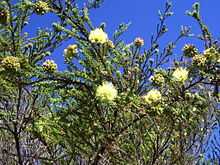Kunzea ericifolia
| Kunzea ericifolia | |
|---|---|
 | |
| Scientific classification | |
| Kingdom: | Plantae |
| (unranked): | Angiosperms |
| (unranked): | Eudicots |
| (unranked): | Rosids |
| Order: | Myrtales |
| Family: | Myrtaceae |
| Genus: | Kunzea |
| Species: | K. ericifolia |
| Binomial name | |
| Kunzea ericifolia (Heynh.) | |
Kunzea ericifolia, known as Spearwood or Pondil, is an erect woody evergreen shrub that is endemic to Western Australia.
Description
K. ericifolia is a woody erect shrub, often multi-stemmed,[1] that can grow to a height of 6 metres[2][3] but is typically about 2 metres (7 ft) tall. The long and slender stems divide from the base, and continue to divide into finer, flexible and narrowly angled branches. The shrub has a crown of soft pale green foliage. The leaf are simple in structure with linear form growing to a length of about 10 millimetres (0 in) with a width of 1 millimetre (0 in). Flowering occurs in spring (July to December) and produces small round flower approximately 10 millimetres (0 in) in diameter. The globular blossom is perfumed and yellow, cream or white in color and occurs in clusters and the ends of branches.[4] Flowers are followed by small single celled fruits that contain many small seed that are dispersed once the fruit is ripe. The bark is fibrous, rough and grey in colour, often peeling in layers from the stem.
Distribution
Kunzea ericifolia is found in the Southwest Australia region. Populations of this species are found as far north as Gingin and as far east as Bremer Bay on the south coast. The largest populations occur around Albany. Many communities are found along the coast-line.[4] A southeastern population is found in the Fitzgerald River National Park. Stands are often found in transition areas between wetlands and drier regions.[2]
Ecology
Kunzea ericifolia grows in sandy well drained soil. Found to grow in peaty soils, quartzite and grey sand. Grows well in moist conditions and along the margins of watercourses, lakes and seasonally wet swamps. Can also be found growing amongst rocks in more open and elevated positions. Requires good drainage and a sunny or slightly shaded position. It is ideally suited to mediterranean conditions, can withstand a moderate frost and will grow in more humid conditions.
K. ericifolia is susceptible to bushfire, which will destroy a thicket, however the seedlings can quickly repopulate an area after these events. The stands are often composed of plants of a similar age and size for this reason. The species can form dense thickets and produces large amounts of leaf litter, an environment occupied by a diverse range of orchid species that includes two rare hammer orchids. The stands also provide shelter to fauna, the New Holland honeyeater builds its nests amongst the branches.[2]
Taxonomy
A species of Kunzea, a genus of the Myrtaceae family, which are found in southern regions of Australia. Kunzea ericifolia was collected by Archibald Menzies during the Vancouver expedition's stop at King George Sound in 1791. The species was first described by Gustav Heynhold, the specific epithet referring to leaves, folium, that resemble the heath family, erica in Latin. A noongar name for the species is pondil and it is commonly described as Spearwood.[2]
Cultivation
The plant has been cultivated for many years as an ornamental plant, though not as commonly as other species of Kunzea. It is easily propagated by seed or by cutting and considered to have greater potential as a garden plant than is currently recognised.[2]
Uses
Studies have found that Kunzea ericifolia contains a powerful natural insecticide (called ericfolione) that has been extracted from the plant using hexane.[5] The stems are used in commercial gardens as supports for climbing plants, for fencing and the construction of craypots. These uses have made the species vulnerable to illegal harvesting.[2]
-

Kunzea ericifolia in a melaleuca thicket (approx 4 m tall), north side of lake seppings
-

Kunzea ericifolia foliage, flowers and fruit.
References
- ↑ "Five Acre Nursery - Kunzea ericifolia". 2002. Retrieved 2007-10-11.
- ↑ 2.0 2.1 2.2 2.3 2.4 2.5 Powell, Robert (1990). Leaf and Branch: Trees and Tall Shrubs of Perth. Department of Conservation and Land Management, Perth, Western Australia. ISBN 0-7309-3916-2.
- ↑ "Association of Societies for Growing Australian Plants ASGAP - Kunzea ericifolia". 2007. Retrieved 2007-11-05.
- ↑ 4.0 4.1 "Florabase - Kunzea ericifolia". 1999. Retrieved 2007-10-11.
- ↑ "A New Insecticidal Pyranocyclohexenedione from Kunzea ericifolia". 1999. Retrieved 2007-10-11.